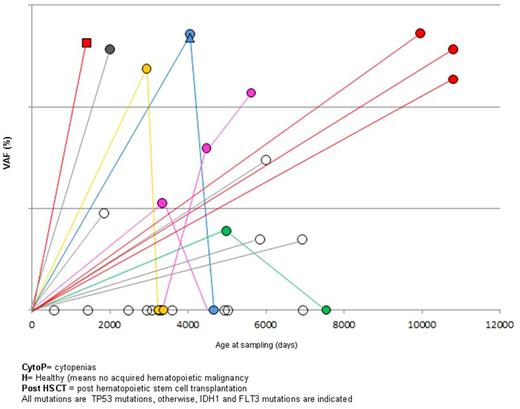Abstract
Context: Shwachman Diamond disease (SDS) is caused by an SBDS mutation, is typically associated with neutropenia and exocrine pancreas deficiency. Pancytopenia, myelodysplastic syndrome (MDS) or acute myeloid leukemia (AML), are life-threatening complications of SDS. To date, the sole risk factors identified for SDS are early symptoms (before age of 3 months) and mild chronic anemia or thrombocytopenia(1).
Methods: To determine which mutations underlie clonal development and leukemic changes in SDS, we screened a series of patients with congenital neutropenias at various time points of follow-up. We used a consensus NGS panel of 41 genes involved in the development of myeloid malignancies (Haloplex® Agilent) (2, 3). Patients with SBDS mutations included in the French Severe Congenital Neutropenia registry or followed in the Leuwen University were screened when bone marrow samples were available as well as other subtypes of congenital neutropenia.
Results: Among the 139 SDS patients, bone marrow samples of 23 patients were available for screening at various time points. We found isolated somatic TP53 mutations in 10 cases. In addition one patient had concomitant FLT3 TKD and TP53 mutations, and another patient had the recurrent IDH1 p.Arg132Cys variant. Strikingly, no TP53 mutations were observed when the screening was extended to 70 non-SDS neutropenia patients. None of the 11 SDS patients without any detectable mutations (with a threshold of detection of 0.5%) had any severe hematological expression nor presented any major hematological complications at time of sampling. By contrast, among the 12 SDS patients with somatic mutations, AML or MDS were observed in 3 cases, 1 with the IDH1 mutation (Variant allelic frequency (VAF): 42%), 1 with the recurrent TP53 p.Gly245Ser mutation (VAF:53%), 1 with two TP53 mutations (VAFs : 19% and 37%). Severe cytopenias without MDS or AML were found in 2 other cases, one with an isolated TP53 mutation at 24%, and one with both TP53 and FLT3 mutations around 45%. In the 7 remaining patients, allele frequencies of TP53 variants were found below 2% in four cases, and at 3%, 14%, and 37% in the 3 other patients. By sequential analysis in one patient we found a p.Val272Met variant (1.1% at 9 years) which was no more observed but was replaced by the recurrent p.Arg175His mutation (4% at 12 years and 14% at 15 years). Figure 1 depicts the allele frequencies of the variants with time among the 23 patients. The three patients with MDS / AML died despite hematopoietic stem cell transplantation (HSCT) in two of them. In contrast, the two patients with severe cytopenias and TP53 mutations who were transplanted are doing well three years after HSCT, and no TP53 mutation was detected one year after transplant.
Conclusion: TP53 mutations are associated with hematological complications and specifically acquired in SDS when compared to other congenital neutropenias. This is in line with the frequency of complex karyotype MDS/AML in SDS(1). Routine evaluation of TP53 load in SDS patients may offer a powerful tool to screen SDS who may be susceptible to have severe hematological complications in a preemptive transplantation strategy setting.
References: 1. J. Donadieu et al., Haematologica 97, 1312 (2012). 2. P. Hirsch et al., Nat. Commun. 7, 12475 (2016). 3. E. Papaemmanuil et al., N. Engl. J Med. 374, 2209 (2016).
Acknowledgments: The French SCN registry is supported by grants from Amgen, Chugai, Prolong Pharma, Inserm, the Association 111 les Arts, the Association RMHE, the Association Sportive de Saint Quentin Fallavier and « Le Fond de dotation Contre la Leucémie". The authors thank the association IRIS and Mrs Grosjean and Mr Gonnot (ASSQF) for their support.
No relevant conflicts of interest to declare.
Author notes
Asterisk with author names denotes non-ASH members.


This feature is available to Subscribers Only
Sign In or Create an Account Close Modal